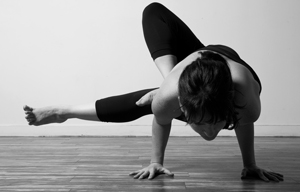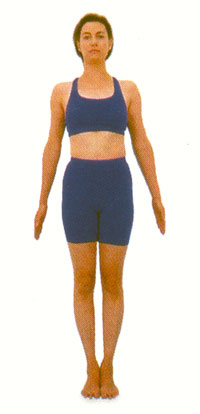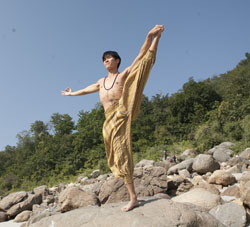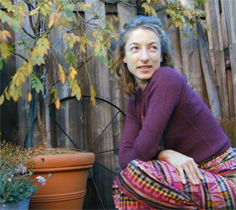By: John Hanc
Published: May 5, 2010
WHEN the world of the business traveler turns upside down — whether because of a missed connecting flight, lost luggage or an uncooperative volcano — Steve Boerema knows just what to do.
He finds a convenient corner in the airport and stands on his head.
Mr. Boerema, who is 45 and lives in St. Augustine Beach, Fla., travels an average of 150 days a year, most of them overseas, as a consultant to the yachting industry. He has also been practicing yoga daily for four years. That practice has now become as essential a part of his business travel as his frequent-flier mileage.
“Initially, it helped me dealing with homesickness and melancholy,” said Mr. Boerema, who is married with two teenage children. “All of us on the road suffer some sort of guilt, being away from our families. Yoga really calmed my head, helped keep me from thinking about things I had no control of.”
Several million Americans practice yoga at least once a week, according to surveys by the sporting goods industry. Many are college-educated professionals in their 30s and 40s, demographics that match those of business travelers, so it is logical that they would adapt their practice to their life in transit.
There is even an app for it: Yoga Journal magazine’s iPractice 2.0, a mobile yoga class for iPhone and iPod Touch. “I knew I had to find something to keep me centered,” says Sarah Howell, a 29-year-old sales trainer for a software company based in Austin, Tex. She started traveling for work three years ago and is now on the road two to three days a week, most months of the year.
Ms. Howell, who writes a business travel blog called the Road Warriorette (roadwarriorette.com), describes herself as “a better person and certainly a better employee,” when she practices yoga while on her business trips. “I’m better able to focus on the task at hand,” she said.
“Research has shown that those who practice yoga and Pilates have improved sleep quality,” said Michele Olson, an exercise physiologist at Auburn University-Montgomery in Alabama. “That’s a big plus for travelers.”
“If you’re sitting for hours on a plane, your hip flexors and hamstrings and other muscles shorten, and we know that can lead to back problems,” Dr. Olson says. “Yoga, because it involves a lot of moves and positions that lengthen those muscles, can be very beneficial in combating joint stiffness at the hip joint and preventing back problems.”
Christopher Berger, an exercise physiologist at the University of Pittsburgh, is leading a task force for the American College of Sports Medicine called “Exercise Is Medicine on the Fly,” designed to promote physical activity among travelers and airport employees.
“Since 9/11, we have very long lines, unpredictable searches and more demands on people,” he said. “There’s certainly psychological stress associated with that. One of our goals for this task force is to get people to use airports as places to blow off that steam.”
Some major American airports do seem to be trying to offer passengers more opportunities to get blood flowing instead of boiling. Detroit Metropolitan Airport, for example, has a marked one-mile walking trail on the airport grounds, and so-called Reflection Rooms in each of its two main terminals — one 720 square feet, the other 357 square feet — where yoga and meditation can be comfortably practiced.
Beryl Bender Birch, a yoga teacher and author of “Beyond Power Yoga” and “Boomer Yoga,” suggested this sequence of three stretches for business travelers.
SEATED FORWARD BEND (relieves stress in the neck, lessons tensions in the hips and lower back caused by lengthy sitting)
Inhale, stretch your arms out in front of you. Fold your hands and interlace your fingers, then exhale and stretch your arms up overhead. Keeping your fingers interlaced, reverse your hands, so your palms are facing up. Arch your back, press your ribcage out and your buttocks forward, tighten your belly, straighten out your legs and point your toes. Feel the shins stretch as the toes point. Look up and back. Take three deep breaths with your mouth closed. Then inhale and release the whole stretch on an exhale. Repeat.
SEATED BACK STRETCH (stretches the back of your body)
Grab your knees with your hands. On an exhalation, pull against your knees with your hands, curl forward, rounding your spine and pushing your back into the back of your seat (make sure the seat-back tray in front of you is up). Drop your head forward and press your chin into your chest. Pull your shoulders up around your ears and round them forward, tighten the belly, pull your heels back toward the bottom of your seat and lift your toes. Feel the stretch all the way from your shoulders to your feet. Repeat.
SEATED SPINAL TWIST (stretches and strengthens sides of body)
Put your right ankle on your left knee in a cross-legged position. Inhale deeply and grab your right knee with your left hand. Lean forward slightly and take hold of the arm rest to your right with your right hand, then exhale deeply and twist as far as you can to the right. Inhale again and as you exhale, pull with your left hand and reach your right arm up in the air. Push your right shoulder back, and look back over your right shoulder. Pull your belly in and take three big conscious breaths with your mouth closed. Repeat.
To read this article in its original format, please see
New York Times
 I first discovered yoga in 1993 – a friend of mine from my dance program took me to a class at the old Jivmukti studio. I started practicing there because the stretching complimented my dance practice. I didn’t know what anyone was talking about at first but was curious about non competiveness nature of yoga – totally different from the dancing I was doing at the time.
I first discovered yoga in 1993 – a friend of mine from my dance program took me to a class at the old Jivmukti studio. I started practicing there because the stretching complimented my dance practice. I didn’t know what anyone was talking about at first but was curious about non competiveness nature of yoga – totally different from the dancing I was doing at the time.
















.jpg)
